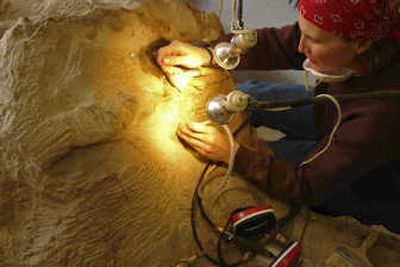Fossil with skin suggests faster, stronger dinosaur

WASHINGTON – One of the most complete dinosaur mummies ever found is revealing secrets locked away for millions of years, bringing researchers as close as they will ever get to touching a live dino, scientists announced today.
The fossilized duckbilled hadrosaur is so well-preserved that scientists have been able to learn that it was more muscular than thought, probably letting it outrun predators such as T. rex.
While they call it a mummy, the dinosaur is not really preserved like King Tut was. The dinosaur body has been fossilized. Unlike the collections of bones found in museums, this hadrosaur came complete with skin, ligaments, tendons and possibly some internal organs, according to researchers.
The study is not yet complete, but scientists have concluded that hadrosaurs were bigger – 3 1/2 tons and up to 40 feet long – and stronger than had been known, were quick and flexible and had skin with scales that may have been striped.
“Oh, the skin is wonderful,” paleontologist Phillip Manning of Manchester University in England rhapsodized, admitting to a “glazed look in my eye.”
“It’s unbelievable when you look at it for the first time,” he said in a telephone interview. “There is depth and structure to the skin. The level of detail expressed in the skin is just breathtaking.”
Manning said there is a pattern of banding to the larger and smaller scales. Because it has been fossilized, researchers do not know the skin color. Looking at it in monochrome shows a striped pattern.
The fossil was found in 1999 in North Dakota and is nicknamed “Dakota.” It is being analyzed in the world’s largest CT scanner, operated by the Boeing Co. and usually is used for space shuttle engines and other large objects.
Researchers have learned enough so far to produce two books and a television program. The TV special, “Dino Autopsy,” will air on the National Geographic channel Dec. 9. National Geographic Society partly funded the research.
A children’s book, “DinoMummy: The Life, Death, and Discovery of Dakota, a Dinosaur From Hell Creek,” goes on sale Tuesday, and a book for adults, “Grave Secrets of Dinosaurs: Soft Tissues and Hard Science,” will be available in January.
Because ligaments and tendons were preserved, researchers could calculate its muscle mass, showing it was stronger and potentially faster than had been known.
They estimated the hadrosaur’s top speed at 28 miles per hour, 10 mph faster than the giant T. Rex is thought to have been able to run.